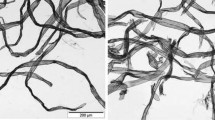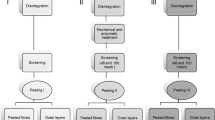Abstract
The swelling and dissolution capacity of dried and never-dried hardwood and softwood pulps and cotton linters was compared in two aqueous solvents, N-methylmorpholine-N-oxide (NMMO)-water at 90 °C with water contents ranging from 16 to 22% and NaOH—water at −6 °C with NaOH contents ranging from 5 to 8%. Swelling and dissolution mechanisms were observed by optical microscopy and dissolution efficiency was evaluated by recovering insoluble fractions. The results show a contrasted picture towards the effect of the never-dried state on the swelling and the dissolution capacity depending on the origin of the fibres and the type of aqueous solvent. In the case of NMMO—water, the presence of water within and around the fibre does not seem to favour dissolution initiation but after 2 h of mixing the dissolution yield appears to be similar for either dried or never-dried state. The limiting factor for dissolution in NMMO—water is not the penetration of the solvent inside the cellulose fibres, but only the local concentration of NMMO molecules around the fibre. For NaOH—water, both optical microscopy observations on individual fibres and dissolution yield measurements show that the never-dried state is more reactive for softwood pulps and cotton linters and has no significant effect on hardwood pulps. In this case, the local decrease of solvent strength is counteracted by the opening of the structure in the never-dried state which should enable the Na+ hydrated ions to penetrate easier.





Similar content being viewed by others
References
Back EL (1967) Thermal auto-crosslinking in cellulose material. Pulp Pap Mag Can 68:T165–T171
Brännvall E (2007) Aspects on strength delivery and higher utilisation of the strength potential of softwood kraft pulp fibres. PhD dissertation, KTH Royal Institute of Technology, Stockholm, Sweden
Clark J d’A (1978) Pulp technology and treatment for paper. Miller Freeman Publications Inc., San Francisco
Cuissinat C, Navard P (2006a) Swelling and dissolution of cellulose part 1: free floating cotton and wood fibres in N-Methylmorpholine-N-oxide-water mixtures. Macromol Symp 244:1–18
Cuissinat C, Navard P (2006b) Swelling and dissolution of cellulose, part II: free floating cotton and wood fibres in NaOH water-additives systems. Macromol Symp 244:19–30
Cuissinat C, Navard P (2008) Swelling and dissolution of cellulose, part III: plant fibres in aqueous systems. Cellulose 15:67–74
Cuissinat C, Navard P, Heinze T (2008) Swelling and dissolution of cellulose, part V: free floating cellulose derivatives fibres in aqueous systems and ionic liquid. Cellulose 15:75–80
Fernandes Diniz JMB, Gil MH, Castro JAAM (2004) Hornification—its origin and interpretation in wood pulps. Wood Sci Technol 37:489–494
Gerber PJ, Heitmann JA, Joyce TW, Buchert J, Siika-aho M (1999) Adsorption of hemicellulases onto bleached kraft fibers. J Biotechnol 67:67–75
Ibbett RN, Kaenthong S, Phillips DAS, Wilding MA (2007) Solute adsorption and exclusion studies of the structure of never-dried and re-wetted cellulosic fibres. J Mater Sci 42:6809–6818
Jayme G (1944) Mikro–quellungsmessungen an zellstoffen. Wo- chenbl Papierfabr 6:187–194
Kato KL, Cameron RE (1999) A review of the relationship between thermally-accelerated ageing of paper and hornification. Cellulose 6:23–40
Klemm D, Phillipp B, Heinze T, Heinze U, Wagenknecht W (1998) Comprehensive cellulose chemistry, volume 1: fundamentals and analytical methods. Wiley VCH, Weinheim
Kunze J, Ebert A, Lang H, Philipp B (1985) Na-NMR spektroskopische untersuchungen zur hydratation von natriumhydroxid in wäbriger lösung. Z Phys Chemie 266:49–58
Le Moigne N, Navard P (2010) Dissolution mechanisms of wood cellulose fibres in NaOH-water. Cellulose 17:31–45
Le Moigne N, Montes E, Pannetier C, Höfte H, Navard P (2008) Gradient in dissolution capacity of successively deposited cell wall layers in cotton fibres. Macromol Symp 262:65–71
Le Moigne N, Bikard J, Navard P (2010a) Rotation and contraction of native and regenerated cellulose fibers upon swelling and dissolution: the role of morphological and stress unbalances. Cellulose 17:507–519
Le Moigne N, Jardeby K, Navard P (2010b) Structural changes and alkaline solubility of wood cellulose fibers after enzymatic peeling treatment. Carbohydr Polym 79:325–332
Lindström T (1986) The porous lamellar structure of the cell wall. In: Bristow JA, Kolseth P (eds) Paper, structure and properties. Marcel Dekker, New York, pp 99–109
Maloney TC, Li TQ, Weise U, Paulapuro H (1997) Intra and inter-fibre pore closure in wet pressing. Appita J 50:301–306
Maloney TC, Johansson T, Paulapuro H (1998) Removal of water from the cell wall during drying. Paper Technol 39:39–47
Mizutani C, Inagaki H, Bertoniere NR (1999) Water absorbancy of never-dried cotton fibers. Cellulose 6:167–176
Nakamura K, Hatakeyama T, Hatakeyama H (1981) Studies on bound water of cellulose by differential scanning calorimetry. Text Res J 51:607–613
Oksanen T, Buchert J, Viikari L (1997) The role of hemicelluloses in the hornification of bleached kraft pulps. Holzforschung 51:355–360
Park S, Venditti RA, Jameel H, Pawlak JJ (2006) Changes in pore size distribution during the drying of cellulose fibers as measured by differential scanning calorimetry. Carbohyd Polym 66:97–103
Robertson AA (1964) Some observations on the effects of drying papermaking fibres. Pulp Pap Mag Can 65:T161–T168
Röder T, Morgenstern B (1999) The influence of activation on the solution state of cellulose dissolved in N-methylmorpholine-N-oxide-monohydrate. Polymer 40:4143–4147
Ruffini G (1966) Improvement in bonding of wood pulps by the presence of acidic groups. Svensk Papperstidn 69:72–76
Stone JE, Scallan AM (1968) A structural model for the cell wall of water-swollen wood pulp fibres based on their accessibility to macromolecules. Cell Chem Technol 2:343–358
Thode EF, Chase AJ, Hu Y (1955) Dye adsorption on wood pulp, IV. Note on effect of drying of pulp on specific dye adsorption. Tappi 38:88–89
Tsuji W, Nakao T, Hirai A, Horii F (1992) Properties and structure of never-dried cotton fibers. III: cotton fibers from bolls in early stages of growth. J Appl Polym Sci 45:299–307
Wang X (2006) Improving the papermaking properties of kraft pulp by controlling hornification and internal fibrillation. PhD dissertation, Helsinki University of Technology, Reports Series A26, Espoo, Finland
Yamashiki T, Kamide K, Okajima K, Kowasaka K, Matsui T, Fukase H (1988) Some characteristic features of dilute aqueous alkali solutions of specific alkali concentration (2, 5 mol/l) which possess maximum solubility power against cellulose. Polym J 20:447–457
Acknowledgments
The authors want to thank Borregaard, Lenzing AG and Milouban LTD for providing the samples. NLM thanks the Carnot Mines institute for its financial support. NDS thanks Viskase®, Spontex®, Sappi, Tembec, Inc. and Lenzing, AG for financial support and vTI/Universität Hamburg for academic support.
Author information
Authors and Affiliations
Corresponding author
Additional information
The CEMEF is member of the European Polysaccharide Network of Excellence (EPNOE), www.epnoe.eu.
Rights and permissions
About this article
Cite this article
Spinu, M., Dos Santos, N., Le Moigne, N. et al. How does the never-dried state influence the swelling and dissolution of cellulose fibres in aqueous solvent?. Cellulose 18, 247–256 (2011). https://doi.org/10.1007/s10570-010-9485-8
Received:
Accepted:
Published:
Issue Date:
DOI: https://doi.org/10.1007/s10570-010-9485-8




